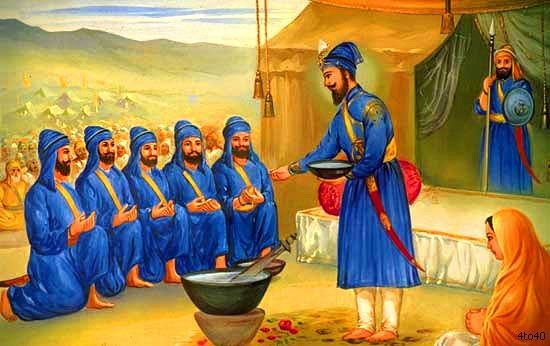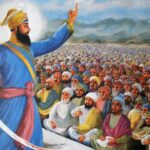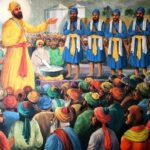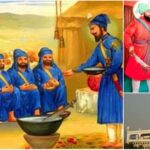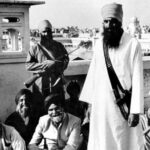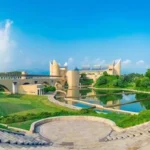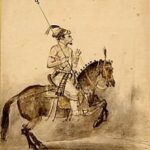The word ‘Khalsa’ signifies ‘freedom’ or ‘sovereignty.’ Guru Gobind Singh Ji, the tenth Guru of the Sikhs, founded the Khalsa Panth on this day in 1699. It was founded to teach its adherents that no ceremony or superstition is greater than Almighty and that no one should believe in them. The Khalsa Panth likewise believes in a single God who is the only Creator and Destroyer, as well as the Master and Protector of everyone.
Guru Nanak Dev Ji, the founder of the Sikh religion, gave the world a new perspective on life and a new philosophy of living with respect. His holy message, which was based on purity, truth, and simplicity, pierced superstitious barriers and captivated people’s hearts.
He made it obvious to the public that only those who love honesty and can stand bravely for justice, fairness, discipline, self-respect, and compassion should join him. In reality, their complete dedication was required. The route was treacherous. The new path’s tough terrain was made known to the followers.
Baisakhi of 1699
Guru Ji sent out a ceremonial invitation to Sikhs all over the nation in early 1699, a few months before Vaisakhi, to attend a special Vaisakhi Diwan in the town of Anandpur Sahib in Punjab State of India, with particular instructions not to trim any of their hair and to arrive with their turbans on.
On the day of Baisakhi, a bed was decked in Anandpur Sahib, as per Guru’s command. The entire Sikh community was in presence. At that moment, Sri Guru Govinda Singh, the tenth Guru, rose and requested five heads to redeem humanity. The audience became motionless as they listened to this.
No one stepped forward for the time being. Guruji made the same demand for a head once more. On Guru Ji’s third call, a Sikh called Daya Ram, a Khatri by caste from Lahore, dropped to his knees and folded his hands in front of the Guru. He meekly said that his body and soul belong to the Guru after begging forgiveness for not answering the Guru’s first appeal. Guru Ji whisked him away to a nearby tent. A large sword sound was heard a few moments later by the audience. Guruji returned with a soiled Sword. The situation became even more incredible. Some people found it difficult to breathe. Guruji then request for yet another head, and Dharam Das, a Jat from Hastinapur (Delhi), Himat Rai, a Jagannath puri water carrier, Mohkam Chand, a Dwarka washerman, and Sahib Chand, a Barber from Bidar all came up and were led to the tent one after the other. The large crowd was becoming antsy to find out what was going to happen next. Guru Ji emerged from the tent after a longer period than before, accompanied by five Sikhs, all dressed in gorgeous colored robes. Their appearance was identical to the Gurus.
Guruji said that the five Sikhs who offered their heads to their faith had shown great bravery and devotion and that they would now be regarded as the Panj Piyare (Five Beloved Ones).
Following that, Guruji created AMRIT (Nector). Guru Ji offered each of them five palms full of Amrit to drink—for inner psyche purification; sprinkled 5 times into their eyes—to see invariably high and good; and sprinkled five times into their hairs—to regard hair as God’s will and source of wisdom, each time making them repeat after him (Guru) “Waheguru Ji ka Khalsa, Waheguru Ji ki Fateh,” meaning thereby – Khals This exemplified Guru’s humility, as he took no credit for the formation of Khalsa and instead declared it to be God’s work.
Guru Ji bowed to Panj Piyare and asked for Amrit so that he might join the Khalsa Panth and change his name from Gobind Rai to Gobind Singh. This meant that the Guru bestowed all glory on the Khalsa and emphasized the value of Amrit, which the Guru did not want to be denied. This is why Guru Gobind Singh Ji is known as “Aape Gur Chela,” which means Guru and Disciple at the very same time. This is how Guru Gobind Singh Ji, the 10th Nanak, accomplished the Mission begun by Guru Nanak Dev Ji, the Sikh Religion’s Founder, on Baisakhi Day in 1699CE.
Baisakhi is celebrated with zeal by Sikhs all over the world as Khalsa’s birthday anniversary. The event was traditionally regarded as a forerunner of happiness and prosperity, as it was intimately associated with harvesting. A traditional dance was performed before the festivities to ward off evil spirits that might spoil the harvest. Bhangra was and still is a famous dance genre in the central districts of Gujranwala, Sialkot, and Gurdaspur, as well as in portions of Jammu.
In practically every gurdwara, akhanAkhands are chanted, followed by kirtan and ardasareas events include communal lunches. Congregational fairs, amritprachar initiation rites for inducting novitiates into the Khalsa fold, and manly sports competitions are held in larger cities.
The most well-attended Baisakhi fairs were in Panja Sahib, in Attock district, and Rminabad, in Gujranwala, until 1947, when the Pb was partitioned (now both in Pakistan). The Golden Temple in Amritsar, the Takht Damdama Sahib at Talwandi Sabo in Bathinda district, and the Takht Kesgarh Sahib in Anandpur Sahib in Ropar district, all in Punjab, are the most important places currently. On the Baisakhi day of 1699, at Kesgarh Fort, Sikhs were first converted to the Khalsa by the administration of change di paul, or baptism of the double-edged sword.
Every year on the 13th of April, India celebrates Baisakhi, a harvest festival. Farmers thank God Almighty and harvest the ‘rabi’ produce on this day. It is a very important part of Indian culture, and it is observed with great delight and festivity all around the country. However, it is extremely religiously significant to Sikhs. The birth of the Khalsa Panth is commemorated by Sikhs. And now you understand why and how it came to be.
